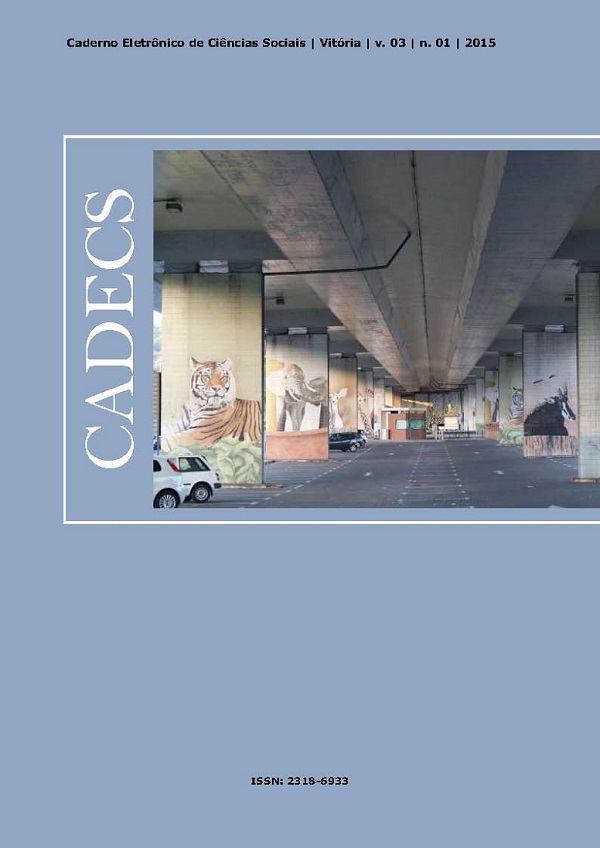Entre o real e o representado: um debate na história dos animais
DOI:
https://doi.org/10.24305/cadecs.v3i1.12275Resumo
A história dos animais é um campo recente que vem sofrendo um progressivo incremento. Na primeira produção da área, o enfoque estava nas representações animais. Num segundo momento, o chamado animal “real” começou a ser incorporado às narrativas. É nesse momento que se observa a centralidade da agência animal, amparada tanto por teorias sociológicas quanto pela incorporação da etologia de viés naturalista. O ensaio faz uma revisão bibliográfica destes dois momentos, apontando para as implicações de se incluir relatos etológicos como fontes para a escrita da história, entre elas, a questão da representação nos relatos científicos e a da reiteração de uma divisão entre ciências naturais e humanas (ou sociais) e os animais como seres naturais.
Referências
APROBATO FILHO, N. 2006. O couro e o aço: sob a mira do moderno: a ‘aventura’ dos animais pelos ‘jardins’ da Paulicéia, final do século XIX/início do século XX. São Paulo. Tese em História Social, USP.
BAKER, S. 1993. Picturing the beast: animals, identity and representation. Champaign: University of Illinois Press.
BIRKE, L. 2002. Intimate familiarities? Feminism and human-animal studies. Society and Animals, Leiden, v. 10, n. 4, p. 429-436.
CRIST, E. 1999. Images of animals – anthropomorphism and animal mind. Philadelphia: Temple University Press.
CROSBY, A. W. 2011. Imperialismo ecológico: a expansão biológica da Europa, 900-1900. São Paulo: Cia. das Letras.
DARNTON, R. 1986. Os trabalhadores se revoltam: o grande massacre de gatos na Rua Saint-Séverin. In: DARNTON, Robert. O grande massacre de gatos e outros episódios da história cultural francesa. Rio de Janeiro: Graal. p. 103-39.
DARWIN, C. 2004. A origem das espécies. São Paulo: Martin-Claret.
DARWIN, C. 2009. A expressão das emoções no homem e nos animais. São Paulo: Cia. de Bolso.
DELORT, R. 1984. Les animaux ont une histoire. Paris: Seuil.
DESPRET, V. 2008. Culture and gender do not dissolve into how scientists ‘read’ nature: Thelma Rowell’s Heterodoxy. In: HARTAMAN, O.; FRIEDRICH, M. (eds.). Rebels of life: iconoclastic biologists in the twentieth century. New Haven: Yale University Press. p. 340-355.
DESPRET, V. 2010. Ethology between empathy, standpoint and perspectivism: the case of the arabian babblers. Disponível em: www.vincianedespret.be/2010/04/ethology-between-empathy-standpoint-and-perspectivism-the-case-of-the-arabian-babblers/ Acesso em: 01 de mar. 2015.
DESPRET, V. 2013. From secret agents to interagency. History and Theory, Middletown, v. 52, dez. Disponível em: www.vincianedespret.be/papers/from-secret-agents-to-interagency/ Acesso em: 01 de mar. 2015.
DUARTE, R. H. 2013. Birds and scientists in Brazil: in search of protection, 1894-1938. In: FEW, M.; TORTORICI, Z. (eds.). Centering animals in latin american history. Durham: Duke University Press. p. 270-301.
FEW, M.; TORTORICI, Z. 2013. Centering animals in latin american history. Durham: Duke University Press.
FUDGE, E. 2002. A left-handed blow: writing the history of animal. In: ROTHFELS, N. (ed.). Representing animals. Bloomington: Indiana University Press, p. 3-18.
FUDGE, E. 2014. What was it like to be a cow? History and animal studies. In: KALOF, L. (ed.). The oxford handbook of animal studies. Oxford: Oxford, 2015 (no prelo). Disponível em: www.academia.edu/10531292/What_was_it_like_to_be_a_Cow_History_and_Animal_Studies. Acesso em: 15 fev. 2015.
GOLDMAN, Márcio. 1999. Lévi-Strauss e os sentidos da História. Revista de Antropologia, v. 42, n.1-2, p. 223-238. Disponível em http://www.scielo.br/scielo.php?script=sci_arttext&pid=S0034-77011999000100012&lng=pt&nrm=iso. Acesso em 20 mar. 2009.
HARAWAY, D. 1991. Simians, cyborgs, and women: the reinvention of nature. New York: Routlegde.
HRIBAL, J. C. 2007. Animals, agency, and class: writing the history of animals from below. Human Ecology Review, s/l, v. 14, n. 1, p. 101-112.
HYAMS, E. 1972. Animals in the service of man: 10.000 years of domestication. London: J. M. Dent & Sons.
INGOLD, T. 2000.The perception of environment: essays on livelihood, dwelling and skill. London: Routledge.
KEAN, H. 1998. Animal rights: political and social change in Britain since 1800. London: Reaktion.
KRUSE, C. R. 2002. Social animals: animal studies and sociology. Society and Animals, Leiden, v. 10, n. 4, p. 375-379.
LANSBURY, C. 1994. The old brown dog: women, workers and vivisection in edwardian England. Madison: The University of Wisconsin Press, 1985.
LATOUR, B. 1994. Jamais fomos modernos: ensaio de antropologia simétrica. Rio de Janeiro: Ed. 34.
LATOUR, B. 2000a. Ciência em ação: como seguir cientistas e engenheiros sociedade afora. São Paulo: Ed. UNESP.
LATOUR, B. 2000b. A well-articulated primatology: reflexions of a fellow-traveller. In: SRUM, S.; FEDIGAN, L. (eds.). Primate encounters. Chicago: University of Chicago Press, p. 358-381.
LATOUR, B. 2001. A esperança de pandora: ensaios sobre a realidade dos estudos científicos. Bauru: EDUSC.
LÉVI-STRAUSS, C. 2008. O pensamento selvagem. Campinas: Papirus, 9 ed.
MARX, K. 2011. O 18 brumário de Luís Bonaparte. São Paulo: Boitempo.
MULLIN, M. 2002. Animals and anthropology. Society and Animals, Leiden, v. 10, n. 4, p. 387-393.
NANCE, S. 2013. Entertaining elephants: animal agency and the business of the American circus. Baltimore: Johns Hopkins University Press.
NOSKE, B. 1993. The animal question in Anthropology: a commentary. Society and Animals, Leiden, v. 1, n. 2. p.185-190.
PASTOUREAU, M. 2010. L’historien face à l’animal: l’exemple du Moyen Age. In: BIRNBAUM, J. Qui sont les animaux? Paris: Gallimard, p. 194-209.
PREMACK, D; PREMACK, A. J. 1994. Why animals have neither culture nor history. In: INGOLD, T. (ed.). Companion encyclopedia of anthropology. London: Rutledge, p. 350-365.
RITVO, H. 1987. The animal state: the English and other creatures in the victorian age. Cambridge: Harvard University Press.
RITVO, H. 2002. History and animal studies. Society and Animals, Leiden, v. 10, n. 4, p. 403-406.
THOMAS, K. 1988. O homem e o mundo natural: mudanças de atitude em relação às plantas e aos animais (1500-1800). São Paulo: Cia. Das Letras.
WALKER, B. L. 2005. The lost wolves of Japan. London: University of Washington Press.
Downloads
Publicado
Edição
Seção
Licença
O Caderno Eletrônico de Ciências Sociais detém os direitos autorais dos artigos nele publicados mediante submissão dos autores .O envio espontâneo de qualquer colaboração implica automaticamente a cessão integral dos direitos autorais ao Cadecs.












